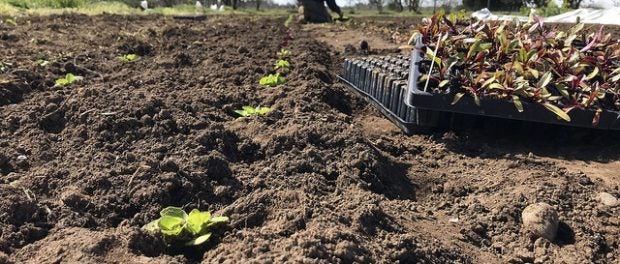COVID-19 Money for Farms – How to Apply

COVID-19 Money for Farms – How to Apply to the Coronavirus Food Assistance Program
Applications opened last week for the Coronavirus Food Assistance Program (CFAP). CFAP is a USDA program that will provide $16 billion in direct aid to farmers who suffered losses due to the COVID-19 pandemic. Applications and payments will be processed through the USDA Farm Service Agency (FSA).
COVID-19 Money for Farms – Who is eligible?
Both individuals and legal entities can apply for funding through the CFAP.
You must be a:
• U.S. Citizen
• Resident Alien providing land, capital, and active personal labor in the farming operation
• Partnership of U.S. Citizens
• Corporation, Limited Liability Company, or other organization recognized under State law
• Indian Tribe or Tribal Organization
• Foreign Person providing land, capital, and active personal labor in the farming operation
• Foreign Entity that has more than 10 percent of its beneficial interest held by individuals that are not U.S. Citizens or Lawful Aliens
Individuals or entities with an average adjusted gross income of more than $900,000 are ineligible unless 75% of their income comes from farming or ranching.
COVID-19 Money for Farms – What commodities are eligible?
The following commodity categories and individual commodities are eligible for payments. Click on the commodity categories listed to view program details from USDA.
• Non-Specialty Crops: malting barley, canola, corn, upland cotton, millet, oats, soybeans, sorghum, sunflowers, durum wheat, and hard red spring wheat
• Wool
• Livestock: cattle, hogs, and sheep (lambs and yearlings only)
• Dairy
o Fruits: apples, avocados, blueberries, cantaloupe, grapefruit, kiwifruit, lemons, oranges, papaya, peaches, pears, raspberries, strawberries, tangerines, tomatoes, watermelons
o Vegetables: artichokes, asparagus, broccoli, cabbage, carrots, cauliflower, celery, sweet corn, cucumbers, eggplant, garlic, iceberg lettuce, romaine lettuce, dry onions, green onions, peppers, potatoes, rhubarb, spinach, squash, sweet potatoes, taro
o Nuts: almonds, pecans, walnuts
o Other: beans, mushrooms
How much aid will you receive?
The payment you will receive will be determined by a USDA formula based on national wholesale prices multiplied by the volume of loss of an eligible commodity. The USDA price formula does not take into account price premiums (including organic). Payments will not be based on actual losses, only based on USDA formulas. If you are a diversified farm seeking payments for a variety of crops and/or livestock, you will need to document and input information for each commodity.
You will need to use the USDA payment calculator to determine your payment rate. It can be found on the CFAP website under “CFAP Application.”
How to get started with your application
To complete the application, it is recommended that you set up an appointment with your local USDA Farm Service Agency (FSA) office. If you do not have an existing relationship with FSA you are still eligible to apply. To find your local service center, please visit the USDA service center locator webpage.
If you are unable to connect with your local agency or would like to speak with someone else, the following hotlines are available to support farmers with the application process:
- Farm Aid hotline: 1-800-327-6243
- ATTRA hotline: 800-346-9140 (English); 800-411-3222 (Español)
- FLAG legal services hotline: 877-860-4349
You will need to gather information about your losses to successfully apply. Begin gathering the following information:
- Production records (2019, 2020)
- Sales records (2019, 2020)
- Quantify of crops unsold (2019) – row crops only
- Livestock inventory (current)
- Quantity of crops shipped but not paid (January 15-April 15, 2020)
- Acres of crops unharvested or that will not be sold (January 15-April 15, 2020)
You will also need to fill out other FSA forms unless they are already on file. Visit the CFAP website to view the necessary forms.
More information about CFAP and the application process
The following guides provide a more detailed account of the program.
- The National Sustainable Agriculture Coalition blog goes into detail about the program.
- The United Fresh Produce Association maintains a COVID-19 financial relief/CARES act resource page for specialty crop producers.
- The Farmers Legal Action Group produced an in-depth guide to the CFAP program for farmers. This guide may be helpful for those with more complex questions about the program.
- For basic information about the program and links to the application, visit the USDA CFAP website.
- Learn about the Coronavirus Food Assistance Program which provides direct payments for farmers at https://www.beginningfarmers.org/cfap-direct-farmer-aid-program/
- Find COVID-19 resources for farmers at https://www.beginningfarmers.org/covid-19-resources-for-farmers/
- Find more COVID-19 resources for farmers at https://www.beginningfarmers.org/covid-19-resources-for-farms-grants-and-more/
- Learn more about loans, grants, and other funding resources at https://www.beginningfarmers.org/funding-resources/
- Get more information about Farm Policy and Agricultural Politics at https://www.beginningfarmers.org/farm-policy-agricultural-politics/
- And as always, find tons of useful farming resources by visiting https://www.beginningfarmers.org/additional-farming-resources/








 Your Privacy Choices
Your Privacy Choices
Leave a comment